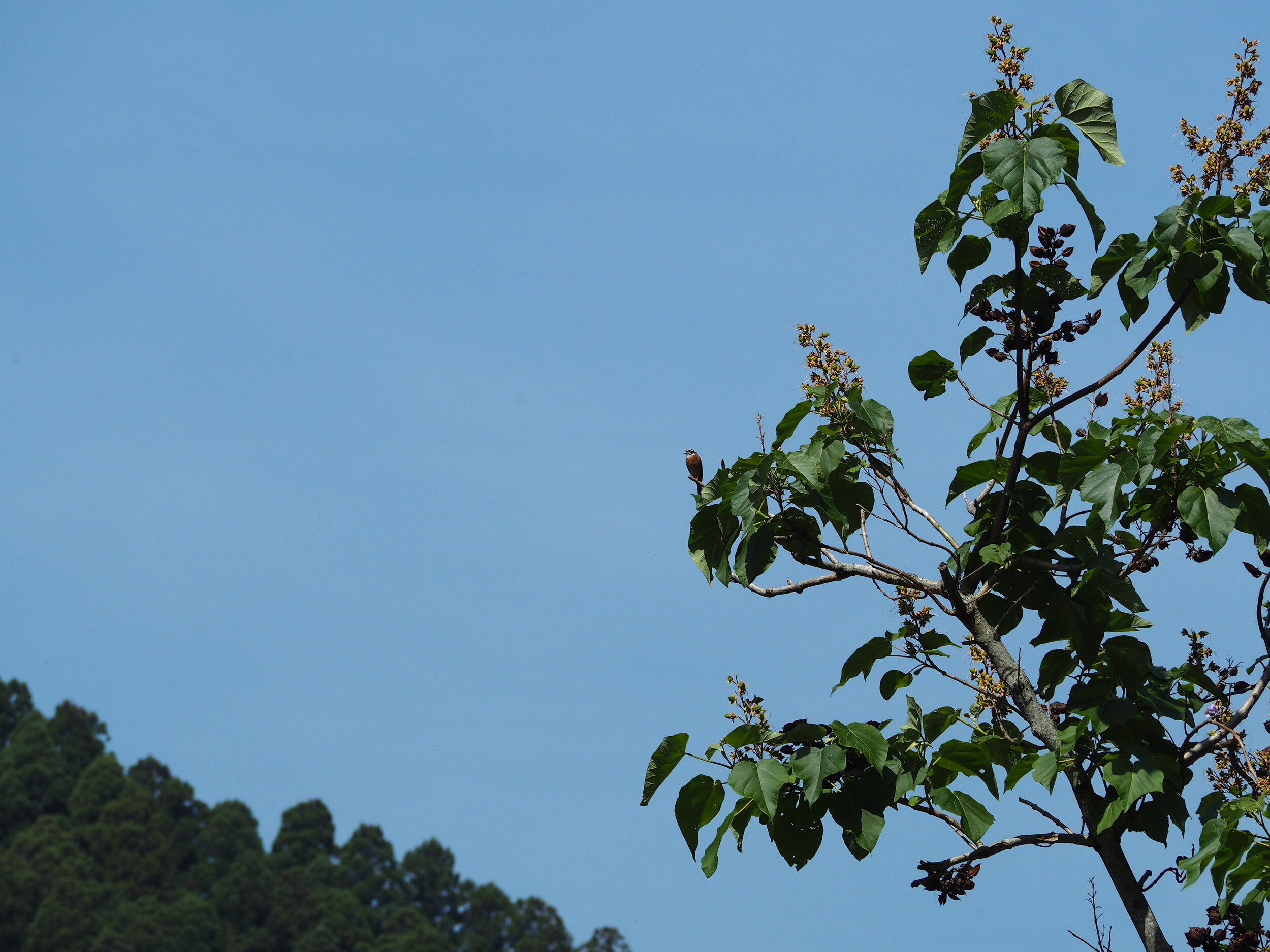野鳥の教訓
今年の春から、僕はかわかみ源流ツーリズムの鳥類調査に同行する機会があった。英語で「早起きの鳥は虫を捕らえる」という諺(「早起きは三文の徳」に近い)があるので、午前5時半にあきつの小野公園から出発すると言われた時、僕はあまり驚かなかった。野鳥の専門家4人、川上村からの3人は公園の駐車場で気楽な挨拶を交わした時、数えきれない野鳥たちも周りの山々からお互いに賑やかな挨拶をしていた。双眼鏡を使って、薄暗い朝空や森林の隅から隅まで探しても、その野鳥たちがなかなか見当たらなかった。先生たちと話しながら、最初の「教訓」を学んだ:野鳥の観察とは、目ですることより、最初に耳でした方が早い、ということだ。
野鳥を耳で探すために、それぞれのさえずりを聞き分ける必要がある。我々人間はそのさえずりを覚えるために、自分の口で「ききなし」を作ったりする。例えば、ウグイスの「ホーホケキョウ」が有名だ。ホトトギスの「東京特許許可局」やキビタキの「ピッピッピッ、クルル」などもあり、ききなしは野鳥の言葉を人間の言葉に翻訳したものだ。覚えておくしかない。
鳥類調査を行うために、僕らは午前中、川上村のあちこちに行き、ヒヨドリやカケスやどんな野鳥を見たかを記録した。僕らは波津地区や上谷地区や上多古川を回ってから、筏場の近くに車を駐めて、双眼鏡とカメラを持ちながら歩いた。村民同士は枯れ木の枝に座っていた、小さなオオルリを見つけた。「鳥は枯れ木が好きですか?」と僕は先生に聞いてみた。「いいえ」と先生は苦笑いで言い、「枯れ木で見つけやすいだけだ」と。それで次の教訓を学んだ:森林の木をいちいち見ることより、木の梢や枯れ木の枝や電線などの見つけやすいところから探す、ということだ。
筏場からの帰り道で、僕らは大迫ダムの近くに車を駐めて、周りの山々と大きな青空を見渡した。しばらく何も見えなかったけど、先生の一人は大きな望遠鏡を向こうの山際へ向けた。「ハヤブサだ〜。そこにいるかなと思いました」と先生は嬉しく言った。僕の双眼鏡で見ても、鳥の小さな輪郭しか見えなかった。先生の望遠鏡のレンズから、山際の岩にぽつんと座っていたハヤブサがはっきり見えた。どれほど見ても、ハヤブサがその上空の風で落ち着いて、じっと座っていた。そのハヤブサを見るだけで、世界がとても静かに感じた。
後日、僕らは大迫ダムに戻って、望遠鏡で猛禽類を探してみたが、あの岩に何もいなかった。それで、今回の最後の教訓を学んだ:どんな野鳥を見ても、その野鳥をまた見られるというわけではない。一回だけの方が普通に感じる。それは目の前を一瞬で横切るカワセミやミサゴかもしれない。何が飛んでくるか分からないからこそ、その瞬間を大切にしよう。
Lessons of Wild Birds
This spring, I had the opportunity to participate in Kawakami Genryu Tourism’s wild bird census. In English, we say that “the early bird gets the worm”, so I wasn’t too surprised when I was told that we’d begin at 5:30 a.m. at Akitsuno-ono Park. When the four bird experts and the three of us from Kawakami greeted one another in the parking lot, countless birds were also energetically greeting one another in the mountains around us. I used my binoculars to search the still dark morning sky and every corner of the forest, but I didn’t find any wild birds. As I was speaking with the experts, I learned my first lesson: Bird watching is a lot faster and easier if you use your ears, not your eyes.
To search for these birds, we have to be able to differentiate between their calls. To help remember those calls, us humans use our own mouths to create an imitation, called a “kikinashi” in Japanese. For example, the Japanese bush warbler’s “hoh-ho-ke-kyoh” is pretty well-known. With the lesser cuckoo’s “Tohkyoh-tokkyo-kyoka-kyoku”, which sounds like a patent permission office in Tokyo, and the narcissus flycatcher’s “pip-pip-pi, kururu”, these kikinashi imitations are examples of the language of birds being translated into the language of humans. All we can do is memorize them.
To conduct the wild bird census, we went all around Kawakami throughout the morning, and recorded all of the brown-eared bulbuls, Eurasian jays, and other birds that we saw. After going around the Hazu district, Kodani district, and up Kodako River, we parked our cars near Ikadaba and walked around with our binoculars and cameras. One of my fellow villagers found a blue-and-white flycatcher sitting on the branch of a withered tree. “Do birds like withered trees?”, I asked one of the experts. “No,” he said with a wry smile, “they’re just easier to find there.” That was how I learned the next lesson: rather than looking at every tree in the forest, it’s easier to first search the tops of trees, branches of withered trees, and power lines first.
On the way back, we parked our cars near Osako Dam and looked across the mountains and the wide blue sky. For a while we didn’t see anything, but then one of the experts aimed his large telescope up toward the edge of a mountain. “It’s a peregrine falcon, I thought one might be there,” he said gladly. Even if I looked with my binoculars, all I could see was a tiny silhouette of the bird. Through the lens of the expert’s telescope, we could clearly see the falcon perched on some boulders all alone at the top of the mountain. No matter how long I gazed at it, the peregrine falcon sat still and calm in the winds of the upper air. Just looking at it made the world feel very quiet.
On a later day, we went back to Osako Dam and searched for more birds of prey, but there wasn’t anything up there on those boulders. That was how I learned the last lesson for this time: Regardless of what kind of wild bird we see, we won’t necessarily be able to see that bird again. Once feels more like the norm. It might be a kingfisher or osprey that crosses right before our eyes in a moment. Since we never really know what’s going to come flying by, let’s enjoy those moments.


